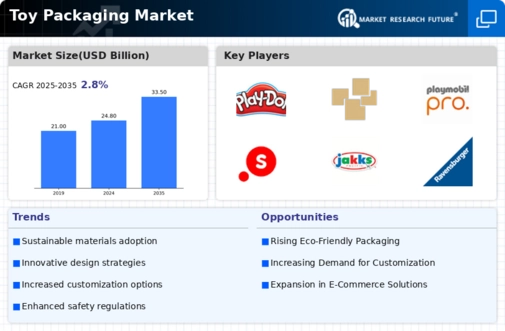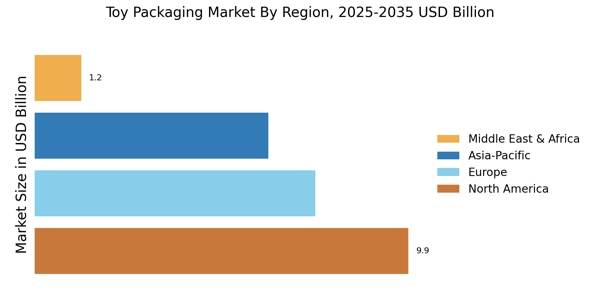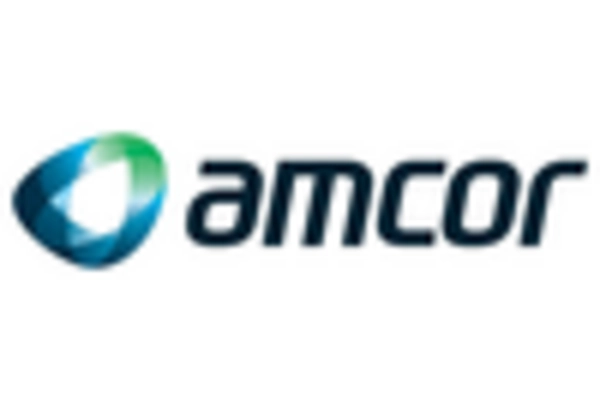E-commerce Growth
The rise of e-commerce has profoundly impacted the Toy Packaging Market. With more consumers opting for online shopping, packaging must adapt to ensure products arrive safely and attractively. This shift has led to an increase in demand for durable and visually appealing packaging that can withstand shipping processes. Data indicates that a significant portion of toy sales now occurs online, necessitating a reevaluation of traditional packaging methods. Companies are investing in packaging that not only protects the product but also enhances the unboxing experience for consumers. This trend suggests that the Toy Packaging Market must innovate continuously to meet the evolving expectations of online shoppers, potentially leading to new packaging materials and designs.
Consumer Preferences
Consumer preferences play a pivotal role in shaping the Toy Packaging Market. As parents and gift-givers become more discerning, the demand for packaging that reflects quality and safety is on the rise. Research indicates that consumers are increasingly favoring packaging that is not only visually appealing but also functional. This trend has led to a focus on packaging that enhances the overall product experience, such as easy-to-open designs and informative labeling. Furthermore, the influence of social media and online reviews has heightened the importance of packaging aesthetics, as consumers often share their unboxing experiences. Consequently, the Toy Packaging Market must remain attuned to these evolving preferences to ensure that packaging meets the expectations of modern consumers.
Regulatory Compliance
Regulatory compliance is a critical driver in the Toy Packaging Market. Governments worldwide are implementing stricter regulations regarding safety standards and material usage in packaging. These regulations often require manufacturers to ensure that packaging is not only safe for children but also environmentally responsible. Compliance with these regulations can be complex and costly, yet it is essential for market access. Companies that proactively adapt to these regulations may gain a competitive edge, as they can market their products as safe and compliant. The ongoing evolution of regulatory frameworks suggests that the Toy Packaging Market will continue to face challenges and opportunities related to compliance, influencing packaging design and material selection.
Sustainability Initiatives
The Toy Packaging Market is increasingly influenced by sustainability initiatives. Consumers are becoming more environmentally conscious, leading to a demand for eco-friendly packaging solutions. Companies are adopting biodegradable materials and recyclable packaging to align with consumer preferences. In fact, a notable percentage of consumers express a willingness to pay more for sustainable products. This shift not only enhances brand loyalty but also positions companies favorably in a competitive market. As regulations around plastic usage tighten, the Toy Packaging Market is likely to see a surge in innovative packaging designs that minimize environmental impact. The integration of sustainable practices is not merely a trend; it appears to be a fundamental shift in how packaging is approached, potentially reshaping the entire industry landscape.
Technological Advancements
Technological advancements are reshaping the Toy Packaging Market in various ways. Innovations in printing technology, materials science, and design software are enabling manufacturers to create more engaging and functional packaging. For instance, the use of augmented reality in packaging design is becoming more prevalent, allowing consumers to interact with products in novel ways. Additionally, advancements in materials, such as smart packaging that can indicate freshness or safety, are gaining traction. These technologies not only enhance the consumer experience but also streamline production processes, potentially reducing costs. As technology continues to evolve, the Toy Packaging Market is likely to witness a wave of new packaging solutions that cater to both consumer preferences and operational efficiencies.


















Leave a Comment